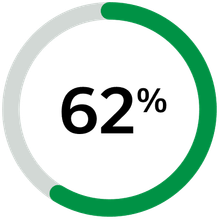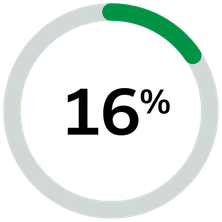The State of Recruitment Report
Here are our top five hiring predictions for the year.
Get The Infographic
After considerable research, we’ve compiled stats to back up a fresh, new perspective on what 2021 holds for the future of recruiting.
TOP FIVE RECRUITMENT PREDICTIONS
- Prediction 1: Remote Work & Video Interviewing Are Here to Stay
- Prediction 2: Greater Emphasis on Diversity & Inclusion
- Prediction 3: Virtual Career Fairs Will Become More Common
- Prediction 4: Speed of Recruitment Will Be More Important than Ever
- Prediction 5: Crafting a Pleasant Candidate Experience Is Paramount
Prediction #1:
Remote Work & Video Interviewing Are
Here to Stay
When the pandemic hit, many teams started working remotely out of necessity. Now, remote work has finally been normalized. It’s been a long time coming, but employers who were quick to embrace remote work, including Basecamp, Trello, and Buffer, are reaping its many benefits.

_VOjPN.png)




Widespread and long-lasting “work-from-anywhere” societal acceptance has resulted in more remote work opportunities. With the exception of some jobs that must still be done in-person, location has become largely irrelevant.
This is good news for employers and employees alike.
EMPLOYERS
Companies now need little-to-no office space, so they’re saving on rent and office overhead.
HR teams can focus on finding the absolute best person for any job—no matter where they reside.
By widening the talent pool to a global scale, it increases the potential for team diversity.
Despite more applicants to consider, time-to-hire is decreasing thanks to faster screening methods and better insights into candidate fit.
EMPLOYEES
Remote work means employees (including recruiters) are afforded better work/life balance and greater flexibility.
Early birds don’t need to wait for the office to open to get to work, and night owls can still be productive after traditional business hours.
Employees aren’t forced to choose between work, family priorities, and living preferences.
No commute! Existing telecommuters reduce greenhouse gas emissions by the equivalent of taking over 600,000 cars off the road for a year.
Adapting to the New World of Work
Since technology is helping us do better work anywhere on earth, it’s no surprise so many recruiters and hiring teams have brought their recruiting efforts online with the rest of their work day. In order to keep job seekers and interviewers safe without halting hiring—especially for essential workers — remote recruitment was very much necessary to keep people safe.
Amazingly, video recruitment software has been available for about 20 years, but it wasn’t until COVID-19 that we collectively saw mass adoption of virtual communication tools and HR tech.
Video interviews and digital pre-employment tests have proven to be so efficient that it’s very unlikely the new way of doing things will end when the pandemic does.
Video interviews are now a popular, and even an expected, part of the modern recruitment process. Everyone is learning best practices for video interviewing, and many people (HR professionals and candidates alike) now think in-person interviews are unnecessary and limiting. Instead, remote work and digital recruitment are likely to remain the norm.
“It is self-defeating if you decide to ‘go remote’ but then hire local people. You want to hire people who are remote and who can work remote. Create a remote environment right off the bat by seeking out remote workers and hiring them.”

Neil Patel
Influencer, Entrepreneur and New York
Times Bestselling Author
Prediction #2:
Greater Emphasis on Diversity &
Inclusion
2020 shone a bright light on systemic injustices, revealing many disheartening biases within society and, regrettably, within certain hiring practices, too.
It’s well documented that diversity makes for a better workforce. Yet hiring bias can still creep into the recruitment process. This can jeopardize your chances of finding the right person for the job—or worse! Legal consequences and a negative brand reputation are just two of the potential dangers of unconscious recruitment bias.
We should want to hire people of color, women, gay and transgender individuals, people with disabilities, and individuals of many different ages. Why? Because diverse talent introduces new perspectives, personalities, and skill sets to help drive better business results.



Prioritizing diversity and inclusion practices in workplaces has become increasingly important for job seekers and employees as well.



Thankfully, due to increased awareness and activism, there have been positive advancements toward greater workplace diversity.

But we still have work to do.



40% of lesbian, gay, and bisexual individuals, and 90% of transgender people have experienced discrimination, harassment, or mistreatment by their coworkers or company









These stats illustrate employers still have a ways to go to level the playing field. We don’t just need more diverse workers; we also need diverse leadership. Without it, according to the Harvard Business Review, women are 20% less likely than straight white men to win endorsement for their ideas; people of color are 24% less likely; and LGBTs are 21% less likely. A disproportionate number of C-level executives (68%) are still white men.
It’s important to remember: diverse teams start with more inclusive hiring practices. One of the proven, most effective ways to minimize hiring bias is to establish a structured interview process—one that asks the same questions, in the same order, in the same way to all job applicants.

Structured interviews have a predictive validity of 62%
Digital structured interviews are expected to increase in popularity throughout 2021 (and beyond) because they are a scientifically-backed way to add fairness to the hiring process. Incorporating standardized interview questions and rating rubrics into HR software makes it much easier for hiring teams to adopt this best practice—regardless of how your team is dispersed. Structured interviewing can help you find the best fit candidates for any position while creating a more inclusive future for employees of all kinds.
Prediction #3:
Virtual Career Fairs Will Become More Common
Much like video interviews, virtual job fairs are also on the rise. For safety reasons during the pandemic, crowded in-person career fairs were cancelled in favor of online alternatives.


Virtual career fairs host a number of benefits for employers and job seekers alike.
For employers and recruiters:
Digital recruitment events are helping hiring teams transcend geographic barriers so they’re able to connect with top talent regardless of where they live and work. This setup also better accommodates individuals who are unable to attend in person, regardless of whether that’s because of illness, a disability, or the candidate’s physical location.
Bonus: Virtual career fairs, coupled with more remote work opportunities, has widened the size of talent pools by opening doors to more applicants on a global scale. In doing so, it’s also increased the potential for workplace diversity because people from anywhere in the world can apply.
For job hunters:
Virtual career fairs are helping job seekers find much-needed employment. Attendees can learn more about available job openings and an organization’s work culture by reviewing curated content at the virtual job fair. They’re even able to ask questions to talent scouts in real-time.
Based on the success of virtual career fairs in 2020, it’s unlikely job fairs will go back entirely to how they were before. Rows of booths in gyms, hotel ballrooms, and convention centers are a thing of the past. Instead, we predict that more campuses and organizations will test drive virtual career fairs because of the many advantages they bring to recruitment.
Prediction #4:
Speed of Recruitment Will Be More Important
than Ever
Unfortunately, COVID-19 caused historically high unemployment. The pandemic has created a large talent pool that is both a pro and a con for hiring teams. On one hand, employers have more applicants to choose from, which means they can be a bit more picky about who they hire.
But then again, speed is of the essence. Hiring teams need to quickly filter out those who are not qualified for the job so they can get in front of the candidates who are—especially before another employer makes them an attractive job offer first.


Some high-performing employees lost their jobs in 2020 simply because of budget cuts. These individuals are still highly employable, and we should consider ourselves lucky that they’re on the job market.
With parts of the economy reopening and a vaccine within arm’s reach, businesses will soon be scrambling to rebuild the workforce we once had pre-pandemic. As society eases into some semblance of normalcy, your competition will be trying to snatch the brightest, hardest-working employees before you can.
Now more than ever, you can’t risk losing top talent. Data shows candidates expect the job application process to be quick and easy.


To collect and sort applications quickly, consider accelerating your talent acquisition efforts with the right HR tech.
Hiring teams worldwide are quickening their recruitment with a combination of these methods:
- Posting vacancies on many job boards simultaneously
- Video interviewing, especially pre-recorded interviewing software, which can be done independently from interviewers
- Interview scheduling software eliminates annoying games of phone tag and long email chains to find a mutually-convenient time to meet
- Automated reference check software means no more chasing references
- Digital pre-employment skills tests provide better insights into how applicants would perform on the job
- “If this, then that” personalized, automatic emails and texts sent based on applicants’ responses throughout the hiring process
Since employers must act quickly to score the best players for their team, speed of recruitment is predicted to be at the forefront of HR professionals’ minds for the foreseeable future.
Prediction #5:
Crafting a Pleasant Candidate
Experience Is Paramount
Regardless of when you’re hiring new employees, finding the right people for open positions will always reign supreme.

Amazingly, only 16% of new hires have the necessary skills for the job
Your job as an HR or recruitment professional is to hire great people for the work that needs to be done. But remote work acceptance means more access to more job opportunities worldwide.
The candidate experience doesn’t end when you decide not to hire someone. Applicants have
likely put considerable time into rewriting their resume and cover
letter and taking time out of their day to participate in interviews. The least you can do for applicants is to provide them with
some kind of feedback. It may seem counterintuitive, but in
doing so, you may help pacify disgruntled applicants and
encourage future applicants.
After all, candidates
are less likely to wait for work, and they are unlikely to stay
quiet about negative experiences.



So, the question becomes: how can you create a more candidate-friendly experience? An intuitive, transparent application and interview process is
key to the future of recruitment.
If you’ve reviewed
someone’s application and think they’re worth pursuing, let them
know what they can expect next. This engages talent sooner than
later, helping you win their favor.
-
Provide clear expectations about the number of steps and the
types of interviews they’ll participate in throughout the
interviewing process.
- Share tips to ace video interviews, which we’ve learned are here to stay. This way, candidates can prepare to present themselves in the best light and reduce pre-interview anxiety, improving the overall experience.
Taking thoughtful, proactive steps to improve the experience can correlate with securing top talent.

Organizations that invest in a strong candidate experience improve the quality of their new hires by 70%
With so much on the line for hiring teams, the candidate experience has never been more important. It’s a prediction that extends well beyond 2021.
CONCLUSION
The people you choose to hire are those who will supercharge
your workplace. That investment in talent can’t be shortchanged,
but it is colored by the transformative effects of 2020.
We look forward to what 2021 brings for recruitment!
Wrap Up
- Hiring adjustments made during the COVID-19 pandemic have inspired permanent changes to the future of recruitment.
- In haste, some organizations mistakenly implemented the wrong HR tech or online hiring approach. Now that remote recruitment is here to stay, consider investigating your options and rethinking your hiring strategy. After all, digital recruiting should make your job easier, not harder.
- The flexibility of WFH/WFA introduces a larger, more diverse talent pool. That, coupled with the large number of people looking for work, creates an overwhelming number of applicants for some positions. Recruiters need solutions to quickly filter out those who are not fit for the job. Employers need to get in front of top talent and offer them positions before they choose to work elsewhere.
Grab your free pocket-sized State of Recruitment report!
Engage, interview and hire top talent, faster, with VidCruiter.
REQUEST A DEMO


_1cwbCn.png)